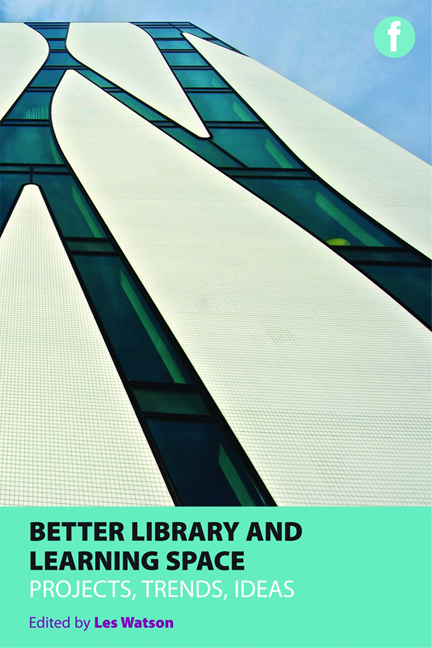Book contents
- Frontmatter
- Contents
- Case studies
- Acknowledgements
- Contributors
- Introduction – about this book
- PART 1 PROJECTS AND TRENDS
- PART 2 TRENDS AND IDEAS
- PART 3 IDEAS AND FUTURES
- Introduction
- 11 Beyond space: access is all – or is it?
- 12 Thinking inside the box
- 13 Nothing has changed/everything has changed – the enduring aspects of learning
- 14 Books, nooks and MOOCs
- 15 The researcher's view: context is critical
- 16 Libraries in the network society: evolution, revolution, extinction?
- 17 Powered by learning: developing models of provision to meet the expectations of new generations of students
- 18 The library has left the building
- 19 Beyond analogue: the learning studio as media-age library
- 20 3D libraries for 3D smarting
- 21 Learning landscapes, the library and the University of Lincoln: efficiency, effectiveness, expression and experimentation
- 22 Viral design: learners building better environments together
- 23 The interior designer's view
- 24 Furniture fit for the future – a brief exploration of library and learning furniture today and for the coming generation
- 25 Conclusions
- Index
13 - Nothing has changed/everything has changed – the enduring aspects of learning
from PART 3 - IDEAS AND FUTURES
Published online by Cambridge University Press: 08 June 2018
- Frontmatter
- Contents
- Case studies
- Acknowledgements
- Contributors
- Introduction – about this book
- PART 1 PROJECTS AND TRENDS
- PART 2 TRENDS AND IDEAS
- PART 3 IDEAS AND FUTURES
- Introduction
- 11 Beyond space: access is all – or is it?
- 12 Thinking inside the box
- 13 Nothing has changed/everything has changed – the enduring aspects of learning
- 14 Books, nooks and MOOCs
- 15 The researcher's view: context is critical
- 16 Libraries in the network society: evolution, revolution, extinction?
- 17 Powered by learning: developing models of provision to meet the expectations of new generations of students
- 18 The library has left the building
- 19 Beyond analogue: the learning studio as media-age library
- 20 3D libraries for 3D smarting
- 21 Learning landscapes, the library and the University of Lincoln: efficiency, effectiveness, expression and experimentation
- 22 Viral design: learners building better environments together
- 23 The interior designer's view
- 24 Furniture fit for the future – a brief exploration of library and learning furniture today and for the coming generation
- 25 Conclusions
- Index
Summary
The limitations of ‘library’
It is sometimes depressing when talking to clients about libraries that they lapse into traditional notions of what these spaces might be. But it is easier to pigeon-hole a concept into a traditional building type than deal with the socio-technical complexity that the concept involves.
Thus on the one hand ‘library’ is a misleading shorthand for something ever-changing and far more complex than it once was, but to suggest, on the other, that it does not include enduring aspects of the process of learning and working is equally wrong. What is important is to understand the fundamental human processes at work in the new concept of ‘library’ and not be confused by either traditional or futuristic images. Image, when we come to it, will be critical, especially in establishing the attitudes of users to what is possible, but image is only ‘image’. In adopting instead a fundamentalist, ‘space usability’, activity-led approach to library design one can avoid becoming a ‘style monger’ and free oneself up for a more creative approach. At haa design we have applied an activity-led approach to the design of various building types and found this liberating. It may not be dramatic but it enables us to look into the future in a way that can provide genuine clues of what might lie ahead. It is an approach that has worked within the evolution of other building types where, far from inhibiting the development of ideas, it has led to massive, liberating change and an escape from either traditional or futuristic cliché.
Activity-led design
What is ‘activity-led design’ and why is it key to developing an idea of the library of the future? Da Vinci's and Le Corbusier's icons of ‘modular man’, a man whose physical proportions underlie the appropriate design of all usable spaces, will be familiar to many, but these icons draw attention only to our anthropometric needs, to the way that the design of spaces to be used by humans requires ultimately to relate to the proportions of the human body. What is less celebrated (and also less succinct) is an analysis of man's basic psychological and emotional needs, our ways of behaving and operating, and yet these needs constitute the corresponding building blocks of good design.
- Type
- Chapter
- Information
- Better Library and Learning SpaceProjects, trends and ideas, pp. 167 - 174Publisher: FacetPrint publication year: 2013

